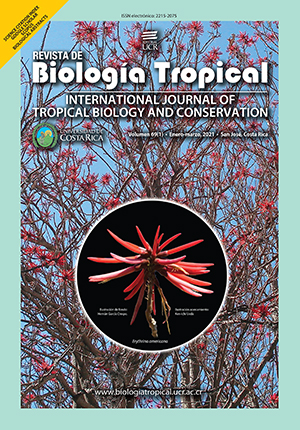Resumen
Introducción: En las últimas décadas los estudios relacionados con la búsqueda y caracterización de moléculas bioactivas en organismos marinos han aumentado de una manera exponencial, lo que demuestra la enorme riqueza de metabolitos secundarios de diversa composición estructural que no pueden ser encontrados en organismos presentes en el medio terrestre. Estas nuevas moléculas halladas poseen numerosas actividades biológicas que ayudan a resolver muchos problemas que ha tenido el hombre a lo largo de su existencia, lo que las convierte en productos de gran importancia para la humanidad. Objetivo: El propósito de este estudio es la identificación de los ácidos grasos presentes en el pepino de mar Holothuria princeps recolectado en costas del Caribe colombiano, además del análisis de las actividades antibacterianas y antifúngicas de su extracto metanólico frente a cepas de referencia y aislados clínicos. Métodos: Del material biológico recolectado se realizó una extracción metanólica usando el método de maceración en frío. El extracto obtenido se fraccionó usando cromatografía en columna y se lograron obtener los ácidos grasos, los cuales fueron derivatizados e identificados por medio de cromatografía de gases en acople con espectrometría de masas. La actividad antibacteriana y antifúngica del extracto metanólico de Holothuria princeps se realizó a través del método de microdilución. Resultados: Los resultados arrojaron la identificación de 16 ácidos grasos presentes en Holothuria princeps de acuerdo con el análisis de sus espectros de masas. La actividad antibacteriana mostró que Enterococcus faecalis fue la bacteria más susceptible al efecto del extracto a bajas concentraciones, mientras que a las más altas lo fue Pseudomonas aeruginosa. A nivel general en el tratamiento antifúngico, el hongo que presentó una mayor inhibición fue el aislado clínico de Candida albicans (muestra de sangre). Conclusiones: Teniendo en cuenta estudios previos en organismos del mismo género, se puede considerar en cuanto a los ácidos grasos identificados, que el entorno juega un papel fundamental en la presencia y composición de estos compuestos. La evaluación de la actividad antibacteriana contra cepas de referencia de Escherichia coli, Pseudomonas aeruginosa, Staphylococcus aureus, Klebsiella pneumoniae y Enterococcus faecalis, demostró la existencia de un efecto considerable en la reducción del crecimiento bacteriano por parte de los extractos utilizados, principalmente a bajas concentraciones (menos de 1 000 ppm). En cuanto a la actividad antifúngica frente a la cepa de referencia de Candida albicans y a los aislados clínicos de Candida albicans (muestra de sangre) y Candida krusei (muestra de catéter), el extracto mostró que los mejores resultados se presentaron concentraciones por encima de 1 500 ppm.
##plugins.facebook.comentarios##

Esta obra está bajo una licencia internacional Creative Commons Atribución 4.0.
Derechos de autor 2021 Yeinner Quiroz Lobo; Gilmar Santafé Patiño; Jorge Quirós-Rodríguez







